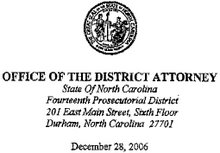Monday, March 12, 2007
This is the third of a series of essays examining the art and science of scapegoating as a separate field of endeavor. As one of the comments to the previous two essays in this series pointed out, the scariest part is that what I have been writing, which started purely as a form of amusement and entertainment, doesn’t really seem that farfetched, given the things we’ve seen in the Duke lacrosse incident.
.
Today’s topic is sin selection. Exploration of this topic is best done by keeping in mind the traditional purposes of scapegoating and how those traditional purposes are used in modern times to further the scapegoater’s hidden agendas.
.
Background:
.
As you will recall, in historical scapegoating, the sins of the community were firmly placed on the scapegoat during a very public ceremony. The scapegoat was then taken far away and out of sight, into the wilderness to die, and was in fact pushed over a cliff. The purpose of pushing the goat over the cliff appears not to have been to kill it outright, but rather to break the poor goat’s legs so it could not return to the community. Thus, the sins placed on the goat could not be revisited on the community, and the goat’s death at the hands of others was made virtually certain.
.
It seems clear the entire practice was intended to have several cathartic results for the community. The community and its members were freed of sin. The community, and its members, could point to someone or something else as the sinner. Then, the object of their blame was taken from sight, and from mind, thus minimizing any guilt the community and its members may have had for the poor goat or for the things the community was allowing to happen to the poor creature. Finally, since the community didn’t kill it, and since even the community’s agent did not kill it, the community and its members could feel even further removed from blame, and from shame, and from guilt.
.
Now, enter your amateur or professional scapegoater of modern times. This scapegoater, in effect, will engage in the entire scapegoating process for a given community … but only if the community effectively gives the scapegoater what he or she secretly (or sometimes not so secretly) wants in return. Further, the truly enterprising and effective modern scapegoater will not necessarily wait for an annual day of atonement. In these modern times, good scapegoaters have become opportunists, ever in search of a situation to exploit. But why stop there? The truly effective scapegoater of today will actively work to create a scapegoating situation where none had existed before. In this respect, scapegoating geniuses are like the marketing wunderkinds so admired in the business community. A marketing wunderkind is at his or her best when they can create a market demand that had not previously been there. However, where the marketing genius creates a need where none had been before, the scapegoating genius creates a problem or a sin or a guilt situation that had not previously existed.
.
Attributes of Appropriate “Sins”:
.
The overriding question for purposes of this essay is what should the scapegoater look for when evaluating potential sins to place on the community’s goat?
1. Relationship Between The Sin and The Scapegoater’s Hidden Agendas:
One limitation the truly inventive scapegoater has is that the payment to the scapegoater must somehow be tied to the particular sins being placed upon the unsuspecting goat. For without guilt, without remorse, there can be no scapegoat fee. Payment of that fee is, after all, a part of the way the community absolves itself of guilt. Further, if anyone thinks for one second a scapegoater works for free, forget it. All scapegoaters want their pound of flesh, and they have little or no incentive to do your scapegoating for you unless they get something in return. Scapegoating, after all, involves a lot of work!
.
But, if it’s done right, everyone gets the best of both worlds. The scapegoater’s hidden agenda is furthered, and thus the scapegoat fee is paid. The community gets a double catharsis, too! The scapegoat, carrying the community’s “sins,” is led away to perish, and the community has a further catharsis by paying the scapegoater’s fee.
.
Nevertheless, the differences between the sin and the scapegoater’s hidden agenda must be kept in mind. And those differences are significant. The scapegoater’s actual agendas or goals often are hidden (or, at the very least, not acknowledged), while the sins must be articulated as publicly and in as attention-directing a manner as possible. Further, the scapegoater’s hidden agenda can be a part of a well orchestrated and coordinated long term, campaign. The sins selected, on the other hand, must be chosen with a view towards destabilization and divisiveness among both the population of potential goats, and at least to the certain extent within the public at large (remember, we are also trying to stifle any potential dissent to our scapegoating efforts, here). And, finally, while the population may get catharsis from the scapegoat being led away, it would not really do for them to comprehend that the scapegoater’s hidden agendas might never be satisfied. Especially if the scapegoater’s fee is paid by granting the scapegoater more power, the odds are very low that granting that power will ever quench the scapegoater’s thirst for more of the same. Once you pay Dane geld, you’ll never get rid of the Dane.
.
This underscores the need to keep the selected sin, which will be used by the scapegoating process to provide a (temporary) catharsis to the community, and the scapegoater’s agenda, separate in both thought and planning. Sin identification is important to the process itself. The scapegoater’s agenda, on the other hand, goes directly to the scapegoater’s motivations. The two are not necessarily the same, and confusing them potentially can lead to costly mistakes.
.
2. Negativity:
.
A second aspect of the sin is that it must be negative. The sin itself must create a problem. It helps if that sin is somehow seen as morally reprehensible. And further, the best sins should evoke either outrage, guilt, or both!
.
Remember, it is far easier to manipulate people to hate than to love. It is far easier to sow distrust or mistrust than to earn trust. One incites a riot through hate and frustration, not joy or satisfaction. Discomfort is far easier to engender in a person than is comfort. And it is far easier to “guilt” someone than to make them feel good about themselves.
.
And these negative emotions are what the scapegoater absolutely needs! They fit right in with the scapegoating process! The good scapegoater identifies, or creates, or builds, or magnifies these negative things. The scapegoater then creates a target for people to dump those feelings on. And then the scapegoater offers to take them away, and to absolve (if only for a moment) people of those feelings. All the community has to do is to acquiesce in the process and also to pay the scapegoater’s fee (explored in detail in the “Milk it for All You Can” essay, which is forthcoming).
.
3. Appropriate Targets and Segregation:
.
Another aspect of a good “sin” is that it should create a means of segregating the “sinners” (your population of prospective scapegoats) from the rest of the community. There are three overriding reasons the scapegoater wants to do this.
.
First, you can’t scapegoat at all if you don’t have an appropriate scapegoat upon whom to lay that sin. In this sense, sin selection and scapegoat selection go hand in hand.
.
Second, it is a fundamental part of the scapegoating process that the targeted scapegoat can be seen as somehow “different from,” “segregable from” or “divisible from” the community the scapegoater is trying to involve in the process. It is absolutely essential to be able to create an evil “them” for the morally aghast “us” in the community to point the bony finger of blame at. And it makes the scapegoating process much, much easier if the community has that very clear and well-demarked “we” versus “they” perspective.
.
Now, privately, and in whispers, members of the community might very well be saying “thank God it’s not me,” but it is imperative that publicly, at least, the bony finger of blame can be pointed by us all towards that flock of goats, and not at ourselves. Otherwise, why would the community buy in to the scapegoating process at all?
.
The third reason that divisiveness is essential concerns the things to be done to the scapegoat as a part of the scapegoating process. In essence, by having a clearly segregable portion of the population, it is much easier to isolate that segment and lead it or one of its members out into the wilderness. The importance of being able to isolate the scapegoat or the scapegoat population will be explored in the “Into the Wilderness” essay.
.
4. Community Comfort Level:
Another aspect of the process is that the sin has to be one the community is comfortable with using and one whose use the community will accept. For this entire process to work, there must, absolutely must, be community buy-in. Without it, the scapegoater is toast!
.
These issues are best illustrated by example. Racism (against minorities such as African Americans, at least) achieved the status of a traditional “sin” sometime in the 1950s or 60s, and became a “comfortable” sin to describe and acknowledge by the end of the 1970’s, at the latest. However, racism against other minorities has never enjoyed that degree of acceptance, and racism against what have been traditionally seen as “majority” population subgroups, such as Caucasians (i.e., “reverse discrimination”), has never really caught on at all. So, there’s an established comfort level for pandering to white-on-black racism as a scapegoating sin, but there decidedly is not a comfort level at this time for pointing to black-on-white racism as a scapegoating sin.
.
Similarly, sexism has achieved that comfort level by the end of the 1980’s, at the latest. Sexism against males, however? Forget it; it isn’t on anyone’s radar screens.
.
Other issues become more problematic. Wealth, in and of itself, is not a crime. People can be envious if someone acquires a whole bunch of wealth, but that in and of itself is not a sin. So, Bill Gates is safe at present.
.
Nevertheless, if such wealth is acquired through other sins, such as exploitation of women, or minorities, or of labor, or crime, or cheating, ordinary wealth can be morphed into “sinful” wealth. Also, if wealth is not acquired, but is instead inherited, that wealth can be sinful wealth, and people will be much more comfortable attacking it.
.
Athleticism as a sin, perhaps? Prior to the 1990s, I think the answer would be it was not viewed as such. Recently, however, there are signs that it may be slowly and haltingly moving towards acceptance as a “sin.” But it’s not there yet, and there are potential problems with it. One problem is that athletes who are members of a minority may be using athletics as a means to get a college education, legitimate wealth, or to achieve other, laudable goals. So, as a general proposition, being an athlete has not yet risen to the status of being a stand-alone “sin” that can be used by a scapegoater.
.
5. Sin by “Association”:
.
As can be seen, not all potential “sins” are necessarily sins the community will have a comfort level with, and this can affect the degree to which the scapegoating effort is accepted. And if it’s not accepted, the scapegoater is in deep trouble.
But fear not! Creative wordsmithing and use of association can turn almost anything into a sin. If wealth is not a traditional sin, but inherited wealth is a bit easier for people to accept – if athleticism is not a sin but racism is – if going to a good school is not a sin… why not combine the three and create an absolutely new category of sin – we can call it “class” or … ta daaaaaaa! PRIVILEGE!!!!!
.
So, never give up hope. With creative wordsmithing, almost anything can be made “sinful”!
.
6. Communications Issues:
.
Next, for scapegoating to be effective, as large a community as possible should be involved in the process (this doesn’t mean they have to know what they’re doing – far from it! It does mean they need to be at least acquiescing to the process, though). For this to happen, though, the process must be visible and very, very public. Thus, the selected sins must be able to grab the attention of a large, or at the very least, influential, audience. And communication is the key. Find a communicable sin!
.
The implications are obvious. For scapegoating to be as effective and wide-reaching as possible, the cooperation of the media in your efforts to lay blame is essential. For this to happen, key players in the media must be persuaded to buy into these efforts, or they must have already bought in to such efforts, and be comfortable with the message the scapegoater wants to broadcast. This issue will be discussed in detail in the “Laying on of Blame” section (forthcoming). Nevertheless, it is definitely a consideration to keep in mind during sin selection.
.
7. A good “victim” also helps:
.
Finally, even though it is not essential, the scapegoater should generally try to find a good “victim” to juxtapose against the contemplated sin (and scapegoat) of the moment. The more adorable and lovable the victim, the better. Further, the more innocent and helpless the victim can be portrayed to be, the better off the scapegoater will be. Seals, whales, children, small pets, horses, all make great victims. Sheep too, especially little lambs. Goats would make great victims, but they’re off limits, because we select our scapegoats from that population.
.
[A note to the reader: Here, we are using the word “victim” as a term of art, to identify the person, creature or group being presented to the community (the world) by the scapegoater as the “victim” being wronged or sinned against. The actual victim of the scapegoater is, of course, the scapegoat, who will be presented to the world as the “offender.” These contextual distinctions must always be kept in mind, and care must always be taken, when writing or speaking of these issues, to be very clear about the context being used. For purposes of this essay, the word “victim” will always be used to identify the person being presented to the public by the scapegoater as the one being wronged. The actual target of the scapegoater will, in this series, always be referred to as the “goat” or the “scapegoat,” even though that person is, in reality, being victimized by the scapegoater.]
.
Adult humans can also be victims, but they’re not quite as effective, because it’s harder to cast them as either helpless or innocent. Nevertheless, an adult who’s a member of, or a representative of, a demographic that is seen as a minority, or that has traditionally been seen as a population of victims, will also work.
.
However, in selecting and using an adult as a victim (and as a means of identifying and targeting your sin or your scapegoat), pesky and potentially troublesome issues such the perceived character and morality of the victim can come into play. The more morally upright the potential identifiable victim is, the better. The less morally upright the victim is, the less useful that victim will be as a means of building feelings of guilt and shame among the community. Thus, if the potential victim is a stripper, who’s identifiably a big fan of drugs, who was pole dancing at the same time as a candlelight vigil was being held to “support” her as a rape victim, who is identifiably a liar (as in, for example, changing her story a minimum of five times) and whose body has been described as “the Louvre of DNA,” that potential “victim” may not be a “perfect” one.
.
One thing must always be kept in mind, though. While being able to identify a victim almost always helps (unless, of course, that victim turns out to be a total scum-bucket), having an identifiable victim is not essential. It’s always acceptable, albeit less effective, to paint an entire class of people (a sub-population, or demographic, if you will) as a victim. And, the rest of the scapegoating process will float from there.
.
Creating a New Sin:
.
One final point should be made. Sometimes, the “sin” the aspiring scapegoater might want to use is not a good one, because it has not become universally acceptable as a “sin,” and/or because your targeted community does not have a comfort level with it, and thus may not accept it. In this case, it is a very good idea to find another sin the community will be comfortable with, and use that. Then the scapegoater can try to tie in the new “sin” with more “traditional” sins to achieve an associational comfort level, thereby slowly prodding the new “sin” along the lengthy and difficult path towards stand-alone acceptability.
.
This does not mean the scapegoater should give up on his or her desired sin – but it does mean it will take a lot of hard work – perhaps decades of work – before that particular sin will achieve community recognition and acceptance standing on its own. For example, neither “privilege” nor “being an athlete” have achieved the status of a stand-alone sins – but their time may be coming if some people have their way. Tying privilege to racism, sexism and criminal behavior – and doing the same thing with being an athlete – has recently been the subject of a very public attempt to move these two “status” offenses down the path to becoming stand-alone “offenses.” Nevertheless, it will still take a while – maybe. Then again, given the recent rise of certain power-shifting movements such as a certain “Campus Culture Initiative,” that time may be sooner than we think.
.
Conclusion:
.
Selection of the sins to be placed on the unsuspecting goat is a crucial step in the scapegoating process. If the community as a whole doesn’t buy into the sin, the entire scapegoating process, and the scapegoater himself, are placed in considerable peril. Nevertheless, if the aspiring scapegoater pays attention to the considerations discussed in this essay, and possesses the imagination and the gall to use a bit of free association and spin-doctoring, the opportunities to find, and ascribe, suitable, acceptable “sins” to an unsuspecting scapegoat, are virtually limitless.
.
Brand
Subscribe to:
Post Comments (Atom)

























No comments:
Post a Comment